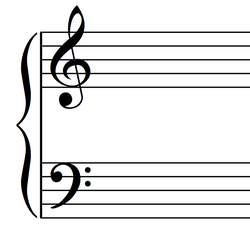Basics of Note Reading
To begin our exploration of music theory, we must first learn how to read music in the staff. Below are important basic terms to memorize:
- Musical Staff - Contains 5 lines and 4 spaces between them. Each line and space represents a musical note in the alphabet
- Musical Alphabet - The musical alphabet consists of the following notes (A-G): A, B, C, D, E, F, G. This then repeats itself.
- Clef - In sheet music, this is normally found at the beginning of the staff. It will determine what notes each line/space represents.
Notes on the Treble Clef

The line notes on the treble clef (from bottom to top) are
E - G - B - D - F. You can remember it by Every Good Boy Does Fine.
Notes on the Bass Clef

The notes on the bass clef lines are G - B - D - F - A. Remember it with Good Boy Does Fine Always.
Grand Staff

For most of the material we are covering, we will use the grand staff. A grand staff is a combination of both the treble and bass clef staffs.
The Piano.
Often times it helps to visualize a piano when thinking of theory. The piano has served as a compositional tool for centuries and much of our music theory is easier to understand when relating it back to the layout of the piano. For those who do not have access to a piano, check out virtualpiano.net for an online interactive piano (I suggest you bookmark this for future reference).




